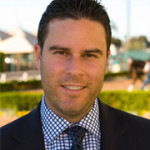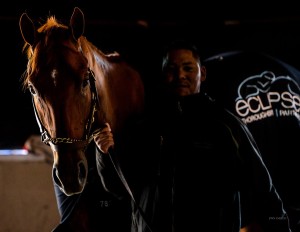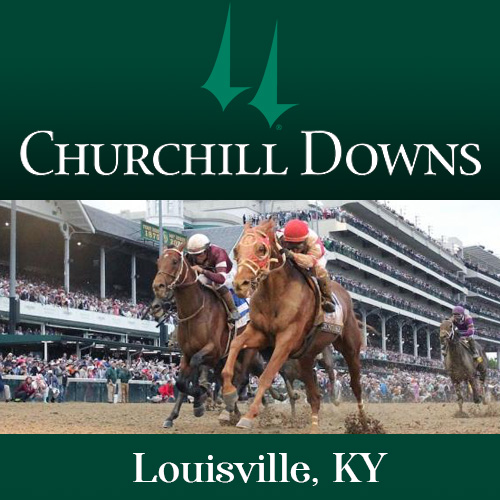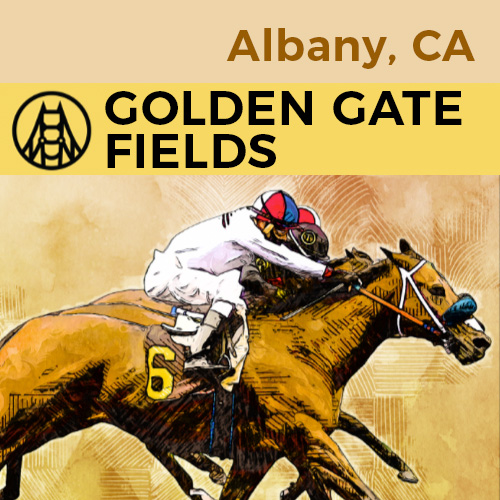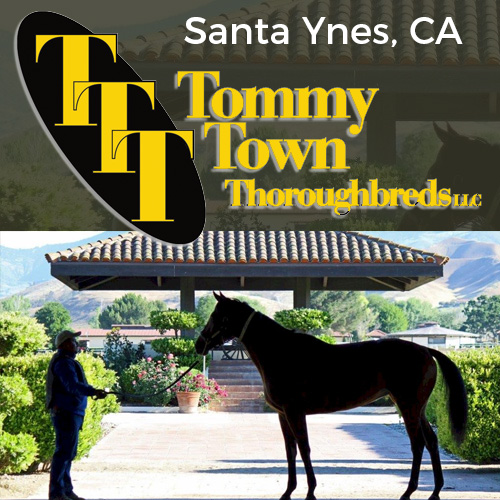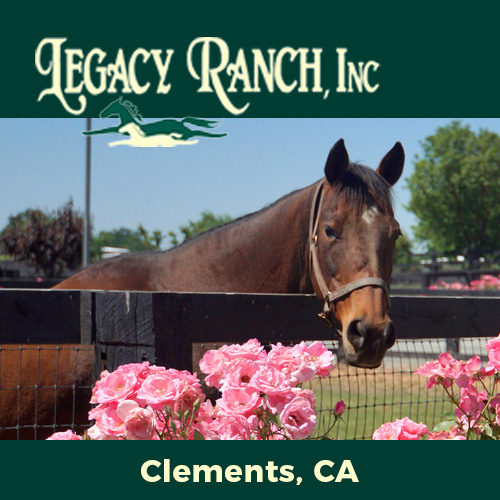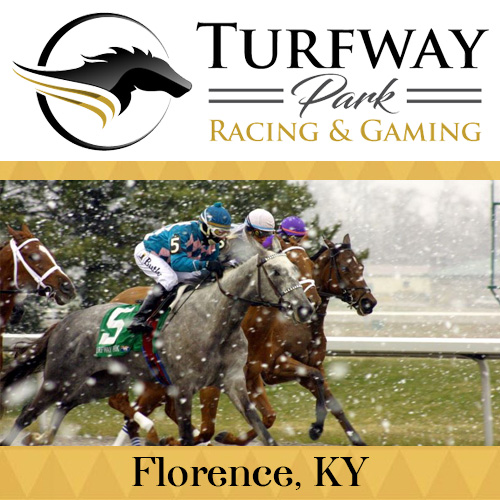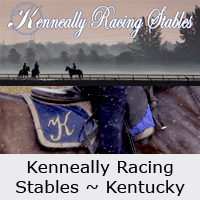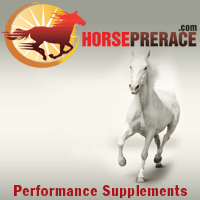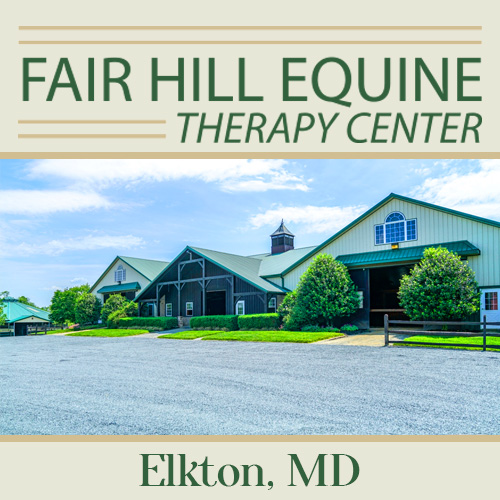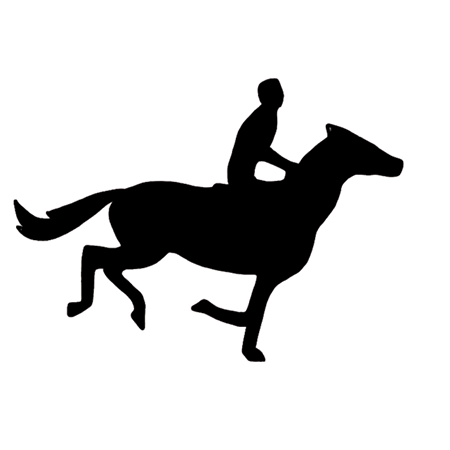The Interviews: Aron Wellman, Eclipse Thoroughbred Partners
Eclipse Thoroughbred Partners, founded in 2011 by Aron Wellman, offers partnerships in top quality racehorses with the aim of finding success at the highest level. Eclipse has made it's mark with multiple Graded Stakes winners such as Danza, Curalina, In Lingerie, Byrama, Capo Bastone and Judy In Disguise. Aron talked to us about Eclipse and his life in racing.
TBP: How did you get involved in thoroughbred racing?
AW: I was basically born into it. My parents have been small-time breeders and owners in California for probably close to 40 years now. My parents bought themselves their first race horse as a wedding gift for one another, so I have them to thank for introducing me to the industry. I also had an incredibly fortunate upbringing in that two of my family's closest friends were Eddie Delahoussaye and Bill Shoemaker, so I grew up around that kind of racing royalty. There's no doubt that I had a passion for horses and racing from a very young age. I would go so far as to say I was obsessed!
TBP: Did you grow up with siblings who were interested in racing?
AW: I have a younger brother, Kyle, he's four years younger than I am. He's more of a handicapper and sticks to that side of it, but he's a big supporter of the partnerships and horses of course.
TBP: I understand you got involved part-time professionally in grooming at the track. Is that correct?
AW: Yes, I was very blessed to spend my summers at Del Mar. When I was a kid I was frustrated by the fact that you couldn't "work" on the backside until you were of age. You couldn't get licensed, for obvious safety, insurance and liability reasons, so kids couldn't really work on the backside with the horses.
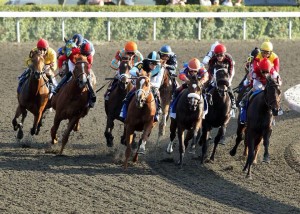 I was lucky to have a summertime neighbor named Jude Feld who was a trainer out here at the time and a wonderful man. I somehow pestered him about helping out at his barn to the point that he finally agreed when I was eight years old. He said, "OK kid, if you're on my doorstep at 4:30am tomorrow morning, I'll take you to the track with me. I'll find a way to get you in." Sure enough, I set the alarm, woke up, and was waiting for Jude on his doorstep at 4:30am. From that morning when I was eight until the time that I graduated from law school I worked every morning and every summer at Del Mar. I started out mucking stalls. To get me in Jude threw me in the back of his car, put a paper over me and we went through security without them knowing there was a kid in the back of his car. He said, "You're here now and now you're on your own." I went over to other barns hustling trainers to muck stalls. I was making about $3 a stall. Jude allowed me to walk hots the next summer and it was a gradual progression from there. I spent a number of years grooming horses every summer. By the time I was in college and through law school, I was to all intents and purposes an assistant trainer.
I was lucky to have a summertime neighbor named Jude Feld who was a trainer out here at the time and a wonderful man. I somehow pestered him about helping out at his barn to the point that he finally agreed when I was eight years old. He said, "OK kid, if you're on my doorstep at 4:30am tomorrow morning, I'll take you to the track with me. I'll find a way to get you in." Sure enough, I set the alarm, woke up, and was waiting for Jude on his doorstep at 4:30am. From that morning when I was eight until the time that I graduated from law school I worked every morning and every summer at Del Mar. I started out mucking stalls. To get me in Jude threw me in the back of his car, put a paper over me and we went through security without them knowing there was a kid in the back of his car. He said, "You're here now and now you're on your own." I went over to other barns hustling trainers to muck stalls. I was making about $3 a stall. Jude allowed me to walk hots the next summer and it was a gradual progression from there. I spent a number of years grooming horses every summer. By the time I was in college and through law school, I was to all intents and purposes an assistant trainer.
Jude was an incredible influence at that time because he never frowned upon the fact that I was young. He allowed me to make mistakes and learn from them and I really felt like I was part of the team. We had some really good horses to learn from. I learned a lot from being exposed to some very high quality animals, but you also learn a lot from the older, cheaper horses too.
The Shoe was always a mentor to me while he was riding. We'd spend a handful of days a year in the jockey's room and I really got that behind the scenes perspective from him. I look back on that now and it was a very surreal experience for a kid to have. When Shoe retired from riding and got his trainer's license, I went to work for him and his assistant trainer Patrick Gallagher. Shoe was immediately given some of the best horses to train in the country. That was a lot of fun.
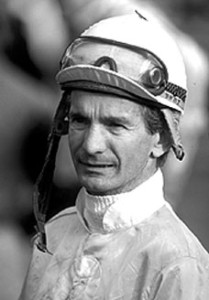 TBP: What were your personal experiences with Bill Shoemaker?
TBP: What were your personal experiences with Bill Shoemaker?
AW: Shoe really was one of a kind. He was a giant of a man. He was an incredibly alive, perceptive human being, not just as a horseman but as a person. He was patient and gentle. It was also his style of horsemanship. I remember the first thing that he ever said to me as I stepped into his barn. He said, "In this barn there will be no force. Everything will be done with composure, poise, care, and gentleness." That's how you get horses to want do things for you. I'm sitting here at my desk and I have a picture of Shoe at my bar mitzvah. He was an incredible prankster, especially in the jocks' room, he was all business on the track but he knew how to have a good time and get a good laugh in off it. At a bar mitzvah party you have certain individuals who are important to you who come up to light a candle. When I called Shoe up, he had a handful of silverware and shoved it into my jacket pocket thinking I would get busted for stealing it when I left.
We lost him too soon. He was on his way to becoming a brilliant trainer but there's no telling what he could have accomplished. The industry certainly misses him.
TBP: Who were the big horses you remember growing up?
AW: John Henry was phenomenal. He was everyman's horse. I remember the tremendous campaign he put together in California and across the country. The horse that was most near and dear to my heart was Ferdinand. He won the Kentucky Derby with Shoe on him when Shoe was 56 years old. He was just a machine.
TBP: Did you consider becoming a trainer?
AW: I really wanted to be a trainer, but everyone geared me away from the trainer profession. My mom said, "You make your own path and make your own money and when all is said and done, you can train your own horses." They wanted me to be a vet, that's not a bad alternative. You get to be around the track and around horses. I went to UC Davis my freshman year for college and passed up some opportunities to play Division 1 soccer with the intention of becoming a vet. However it didn't take me long to realize that that would have been too many years of math and science, so I took a political science path and went to law school. I practiced law for about five years as a litigator. I always promised myself when I got my first "real" job, I would buy myself my first racehorse.
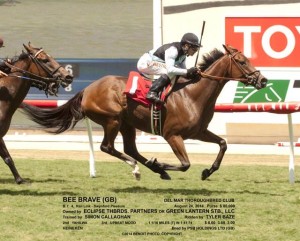 I got hired by a small firm on the west side of LA and started making a bit of money but not enough to have my own horse. Three race track buddies and I got together and claimed a horse for $32,000 called Rhetoric Express. Within a month, he won an allowance race and we lost him for $50,000 several months later. I soon found myself with five, six or seven guys, we would throw our money together and find some horses to have some fun with. Shortly thereafter I formed an informal partnership called LGL Racing. We were primarily a claiming partnership and were looking for quick, fun action and to turn horses over. It was a great way to gain experience in racehorse identification and management.
I got hired by a small firm on the west side of LA and started making a bit of money but not enough to have my own horse. Three race track buddies and I got together and claimed a horse for $32,000 called Rhetoric Express. Within a month, he won an allowance race and we lost him for $50,000 several months later. I soon found myself with five, six or seven guys, we would throw our money together and find some horses to have some fun with. Shortly thereafter I formed an informal partnership called LGL Racing. We were primarily a claiming partnership and were looking for quick, fun action and to turn horses over. It was a great way to gain experience in racehorse identification and management.
I always knew that I had an interest in higher quality animals, so we all agreed to look for higher quality horses and I turned to Europe to find them. It was always a source of horse talent that I was intrigued by. We went over there and bought a two-year old filly from England. Her name was Three Degrees and she had just run second in a maiden race there. She won a couple of graded stakes for us here in the US and was, painfully, second in a couple of Grade 1s including the Del Mar Oaks and the Matriarch. She was a phenomenal filly that put us on the map.
We went back to England the next year and bought another two year-old filly named Valbenny. She became one of the top three year old fillies in California in 2008. In her three year old year she won four or five graded stakes for us. In November after those wins we sent her to Fasig Tipton to be sold as a racing broodmare and she brought $1.2 million. Three Degrees and Valbenny were the first two horses to really put us on the map and the decision to put Valbenny through the sales ring was the decision that reconnected me with Barry Irwin of Team Valor. I originally knew him through my parents when he was living in California. He had been interested in acquiring Valbenny through auction and was wondering if a partnership might be of interest. That didn't work out because she sold for more than we had anticipated, but through that process, Barry and I began to talk. Barry was looking to bring someone on to be his heir apparent at Team Valor and he offered me a position as vice president. I left my law practice and that was the first opportunity I got to become a full time professional in the industry.
TBP: Tell me more about LGL?
AW: We were very casual and loosely held. We started off with a handshake and a lot of trust. Eclipse operates on a much higher level and has a very formal structure. It started off just as trust to invest in the best racehorses and the same principle is at the core of what we do today. We form partnerships and rely on people's hard earned dollars to do it. It all boils down to trust. You can have all the contracts in the world, but it all boils down to trust and I try not to lose sight of that.
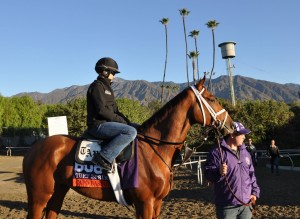 TBP: How long were you with Team Valor and what was the catalyst for you to splinter off?
TBP: How long were you with Team Valor and what was the catalyst for you to splinter off?
AW: I was with Barry for three and a half years and it was an incredible and invaluable experience. I consider Barry to be one of the smartest and most innovative people in racing. Barry's heart is really in the right place and he always wants what is best for the industry. We had an incredible run, I think we won something like 200 races and 50 stakes. At the time I resigned from Team Valor it was a standalone decision. I didn't know what I was going to do, I just believed it was the best thing for me to do for my family and for my career. Shortly after, I was approached by some partners and was presented with the opportunity to start another partnership company in the summer of 2011.
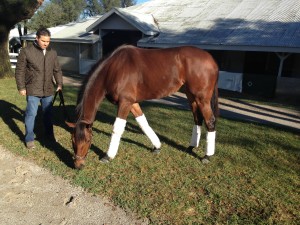 TBP: How has Eclipse evolved this past four years?
TBP: How has Eclipse evolved this past four years?
AW: It has really grown and blossomed beyond my wildest dreams. When we opened our doors in the summer of 2011 I had no idea if a single person would have any desire to be a partner of Eclipse. When you hang up your own sign you have no idea what type of traction you are going to get. I was so blessed to have early support from some wonderful people and to develop a nationwide stable to compete at the highest level. Every horse we acquired for the stable we did so with the intention of it becoming a graded stakes horse. That's not an easy thing to achieve. It has been the biggest challenge of my life, to build a stable from scratch and try to establish it as a nationwide influence on major races.
We started off with just a couple of horses. I intentionally put an emphasis on fillies in particular, I always believed a stable should be founded with fillies. Our resources were limited but I wanted to do my best to find fillies we could develop into assets. We were so lucky in the beginning. The first filly we bought was named Byrama. She won several stakes races and if you could ask what could be your flagship horse you could not have dreamed of a better horse than Byrama. She was as tough as nails. She ran on dirt, on turf, she did it all. Then we took a big plunge in January 2012 and bought a filly called In Lingerie and that was really a strong catch for our growing partner base because she was a significantly expensive purchase at the time. She was a maiden winner on her debut sprinting on the Polytrack at Turfway Park. For our partners to believe in our ability to identify Grade 1 caliber horses and pay a significant sum of money for her, that was a real test.
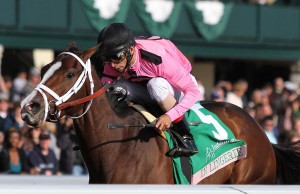 TBP: Where did you pick her up?
TBP: Where did you pick her up?
AW: We acquired her privately from the Lister family after her maiden win. In Lingerie lived up to all her billing. In her second start for us she won the Grade 3 Bourbonette Oaks and then went on to win the Grade 2 Black Eyed Susan at Pimlico, which was the second leg of the Filly Triple Crown. She really put us on the map with that. She went on to be placed in the Grade 1 Coaching Club and the Alabama at Saratoga. Then we won our first Grade 1 with her in the Spinster at Keeneland in the October. To win a Grade 1 at Keeneland with a filly with her classy type of pedigree was a huge event for the stable.
Thankfully, in the first full year of our stable operation, I don't think we had a single injury to any of our horses. We might have had a few 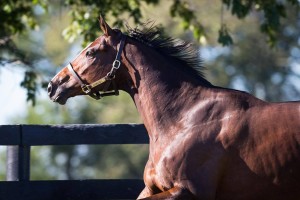 minor setbacks, but nothing that required us to send a horse out to the farm. Not a single surgery, not a single major bump in the road.
minor setbacks, but nothing that required us to send a horse out to the farm. Not a single surgery, not a single major bump in the road.
TBP: Who are your staff at Eclipse?
AW: Jack Sadler, Bill Victor and Kelsey Marshall are full-time employees. A couple of years ago one of the most humbling and wonderful experiences of my life was that we formed a joint venture with Dogwood Stables with Cot Campbell. He is considered to be the pioneer of racing partnerships. When he went into semi retirement, he was looking for someone to carry on the Dogwood legacy. It was a proud and humbling moment for me for Dogwood to merge with Eclipse. That’s how we gained the services of Jack Sadler and Bill Victor, who had been the CEO and treasurer of Dogwood for many years. It was another remarkable stroke of luck that helped Eclipse shoot to the next level with our client and partner base. It enabled us to grow the stable and the brand and played a major role in our being able to grow the way we have in the past several years. It doesn't get any better than Cot Campbell's endorsement. It was the ultimate feather in the cap.
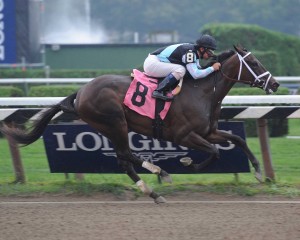 TBP: Are European horses something you still pursue?
TBP: Are European horses something you still pursue?
AW: The market has become incredibly fierce for quality horses anywhere but particularly in Europe. When I started Eclipse, the market was reasonable and my best horses had been prospects from Europe. We did a lot of it for Team Valor and it was something that I thought would be the pinnacle of how our stable would be comprised. We have been fortunate in having several successful European horses, including Byrama and Judy In Disguise. We very much enjoy prospecting talent in Europe, but the problem now is that the rest of the world has picked up on it. With Hong Kong, Australia, and Middle Eastern money it has become difficult to acquire horses of value there. We are value seekers. To get horses which are maiden winners and not pay a premium for them, sometimes multiples of what they are really worth, you have to be very disciplined and not get caught up in that. We still buy a handful of Europeans every season, but what would have been eight, nine, or ten annually has shrunk to three or four at this point, although I still put in all the work looking for those diamonds in the rough. As a result I have had to change our buying emphasis to a large degree to the yearling sales domestically as well as the horses in training sales. I much prefer to buy a proven racehorse, but you have to adapt and adjust to the market to continually produce graded stakes horses.
TBP: Where do you stand on Lasix?
AW: I remember it not being legal in New York, but in California for as long as I can remember it has been legal. There is no question that in our country and industry there is a need for broad scale medication reform. I am of the belief that we could do away with all race medication and, if there was to be any exception to that, to allow horses to run on lasix. I am not the guru of this topic and rely very heavily on a few veterinarians that I respect very much. I don't claim to have the answers to this but, to me, my understanding is that lasix is a therapeutic drug. I know that the common terminology that people like to use is "performance enhancement" but I think this is a dangerous term to use in reference to lasix. I don't 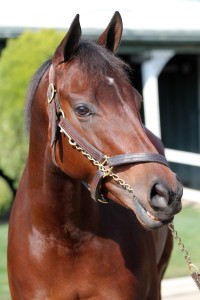 believe lasix, based on the knowledge that I have been given, is a performance enhancement drug. I think it is more of a therapeutic drug. The bottom line is that I think there should be medication reform, and I think if we went to zero tolerance of race day medication the best trainers and horses would continue to thrive. The real gripe I have with the powers that be, who are leading the charge on racing medication is that I feel that there is a gross amount of contradiction and hypocrisy in their own actions.
believe lasix, based on the knowledge that I have been given, is a performance enhancement drug. I think it is more of a therapeutic drug. The bottom line is that I think there should be medication reform, and I think if we went to zero tolerance of race day medication the best trainers and horses would continue to thrive. The real gripe I have with the powers that be, who are leading the charge on racing medication is that I feel that there is a gross amount of contradiction and hypocrisy in their own actions.
I am totally fine agreeing that we can and should go clean. This leads me to "How do you effectuate that change?" There are so many organizations out there with varyingdegrees of interest that it makes it difficult to accomplish. What it all boils down to with me is uniformity. Each state is governed by its own authorized body, but to have medication rules contradict each other from state to state makes no sense and is not in the best interest of the horses, the trainers, or the owners. There have to be nationwide, uniform medication rules. There needs to be uniformity and a central governing body with a national commissioner. A commissioner who decides on all matters that fall under their umbrella. Until we can get our house in order, we can't expect public perception to improve at all.
TBP: Where are you on the synthetic tracks?
AW: For me, there's certainly a place for synthetic tracks. There's evidence that suggests they're safer and I do believe there is a place for them. I think while the intention behind the rush to install these synthetic tracks was good, particularly in California, we jumped into this thing poorly educated, ill-advised and it was a rash call to action that was premature. We didn't understand the track surfaces and I think what really led to their demise was a lack of understanding on how 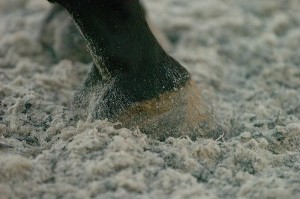 to maintain synthetic tracks. When they came to the fore in the US and Southern California, they were deemed to be an all weather track which required little maintenance. It can be a benefit in climates that are cold, wet, rainy and frozen. That's probably when you're most concerned about the safety of the horse. You take the all weather out of the equation in Southern California, as we don't experience as much climate change as other geographical locations.
to maintain synthetic tracks. When they came to the fore in the US and Southern California, they were deemed to be an all weather track which required little maintenance. It can be a benefit in climates that are cold, wet, rainy and frozen. That's probably when you're most concerned about the safety of the horse. You take the all weather out of the equation in Southern California, as we don't experience as much climate change as other geographical locations.
I really think there were two major mistakes. Number one, I think there were corners cut in the installation of the surfaces. We were in a huge rush to get them installed. I think there were materials that were skimmed and I believe that there were irrigation issues that were overlooked. So you are already creating problem conditions from the beginning. Number two, I believe track maintenance is key to a safe track and these tracks were initially billed as being low to no maintenance. For some reason, especially here in California, they went to the opposite extreme. They were smashing the tracks. Tractors were on these tracks more than on conventional dirt surfaces. I always understood that these tracks should be left alone. I think there was a very poor job done in maintaining them. The trainers wanted them faster and firmer so they were maintained differently to how they were supposed to be maintained.
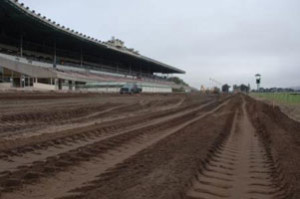 I think the Tapeta surface that Michael Dickinson has come up with is clearly a highly functional very safe surface that has stood the test of time. For me, with the other surfaces I think we did just too much, too soon and the learning curve was too steep to work, it's a shame. I do believe however that synthetics will be back in the future. In a perfect world, every track should have a turf, a dirt and a synthetic surface.
I think the Tapeta surface that Michael Dickinson has come up with is clearly a highly functional very safe surface that has stood the test of time. For me, with the other surfaces I think we did just too much, too soon and the learning curve was too steep to work, it's a shame. I do believe however that synthetics will be back in the future. In a perfect world, every track should have a turf, a dirt and a synthetic surface.
What it boils down to for me is consistency. Tracks themselves need to be consistent on a day to day basis as much as weather will permit. They put in three different surfaces at Hollywood Park, Anita and Del Mar. They put in a Polytrack at Del Mar, Cushion Track at Hollywood Park and Pro-Ride at Anita, none of which had been perfected at that point. The track superintendents had no knowledge of them and the horses were going from one track to the next and having trouble adjusting. When you have to alter from one surface to next, horses are more susceptible to injury.
There are all sorts of safety matters we can work on. All these things are important. When you talk about the general concept of people that aren’t exposed to the industry thinking horse racing is cruel- we suck at public relations, because there's no centralized leadership. It's also because we are reactionary when a crisis occurs instead of being proactive about supporting the immense amount of positivity that our sport nurtures. My reaction when people say horse racing is "cruel" is that I don't argue with them. I say "Would you like to spend the day 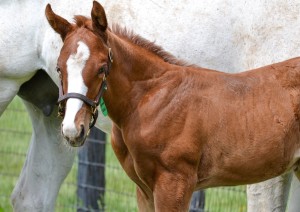 with me on the backside of the racetrack?" I expose them to the manner in which the animals are treated. The look on these people's faces when they are exposed to the royal treatment given to these athletes is priceless. They were previously clueless. Some people seem to think every horse is America is housed in a rat-infested slum. After five minutes of watching how a racehorse is treated at race tracks in America, a lot of them would trade places with that horse in a heartbeat! These horses are pampered and catered to in the most amazing caring way.
with me on the backside of the racetrack?" I expose them to the manner in which the animals are treated. The look on these people's faces when they are exposed to the royal treatment given to these athletes is priceless. They were previously clueless. Some people seem to think every horse is America is housed in a rat-infested slum. After five minutes of watching how a racehorse is treated at race tracks in America, a lot of them would trade places with that horse in a heartbeat! These horses are pampered and catered to in the most amazing caring way.
I think we do a very poor job of exposing the general public to the positivity of the sport. We need to do our part in exposing people to the beauty of the game. There's a deep amount of love, care and respect for these animals that the public just doesn't understand.
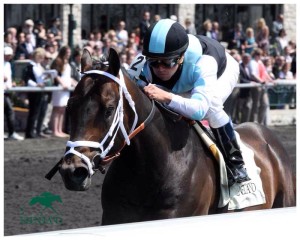 TBP: Are there any things you'd like to do if you were in charge of horse racing for a day?
TBP: Are there any things you'd like to do if you were in charge of horse racing for a day?
AW: There are a couple of general concepts. I think some racetracks are picking up on this. It came to the forefront of discussion in the Derby last year when one of California Chrome's owners rightfully opened his mouth about the treatment which he, his family, and his partner received. I think Churchill responded well this year from what I can tell. I think tracks are doing a good job. The general concept is that there has to be better connectivity between owners and racetracks so that the owners are treated the way they should be treated.
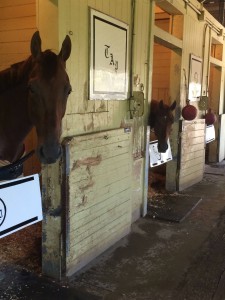 On a broader scale, I'm a proponent of less being more when it comes to race days. I think we've diluted our product almost into oblivion. We're starting to see racetracks with seven or eight cards on a Thursday or Friday. It's so glaringly obvious that we need to shift to a "less racing is more" model. That doesn't mean less races, it means less race days. The novelty of the racing experience has worn off because we offer it almost every day. One of the reasons I think the NFL has become such a success is that they have off seasons and during their seasons, they operate once a week. Sundays in America are football days. It's plausible to think that we can get a better share of the market by making it a little more of an event. I think it would lead to a trickle down process that will find horses staying around longer too. I think if you race two or three times a week rather than four or five, your horses and handlers will be healthier.
On a broader scale, I'm a proponent of less being more when it comes to race days. I think we've diluted our product almost into oblivion. We're starting to see racetracks with seven or eight cards on a Thursday or Friday. It's so glaringly obvious that we need to shift to a "less racing is more" model. That doesn't mean less races, it means less race days. The novelty of the racing experience has worn off because we offer it almost every day. One of the reasons I think the NFL has become such a success is that they have off seasons and during their seasons, they operate once a week. Sundays in America are football days. It's plausible to think that we can get a better share of the market by making it a little more of an event. I think it would lead to a trickle down process that will find horses staying around longer too. I think if you race two or three times a week rather than four or five, your horses and handlers will be healthier.
Whether we go to a zero racing medication policy across the board or not remains to be seen. Regardless, we have to obtain technology as far as testing is concerned to get up to the necessary standards for 2015. That is a must have no matter what the cost. If we can publicize that the highest level of technology is being used for medication testing so that the public perceives that the industry is on the up and up, the cost of it will be far outweighed by the increased gambling dollars that come our way.
Also the fact that our racing track TV and video is not displayed in HD is disgraceful. NYRA has gone HD on their website which is a step in the right direction. When you watch golf and you can see a crystal clear panorama of the ball and the scene, it's a more pleasurable experience and the same applies to watching horse racing of course.
TBP: Tell us more about Eclipse? How does the investment process work for people who are interested in getting involved?
I basically created a structure of 3% increments, in which case you could have as much as 30 partners to a horse. We never actually had that many, but I basically took on all comers. As we've grown and with the addition of Dogwood, which was structured as a four unit partnership with four units per horse, we've tried to continue to cater to the individuals who got us to where we are in the beginning, as well as to the type of partners who prefer to be in smaller partnerships with everyone having a higher equity interest. Some of our partnerships still offer 3% increments where you can get as many as twelve to fifteen people per partnership and some are as small as four partners per horse where it's a 24% increment. On average we are looking at about eight partners per horse.
TBP: Does Eclipse retain an interest in general?
AW: Yes, we retain an equity interest in every horse we buy and manage, which will vary by opportunity. Eclipse is a managing member of each horse. Each horse is its own individual LLC. Each person who participates in the partnership is a member of that LLC.
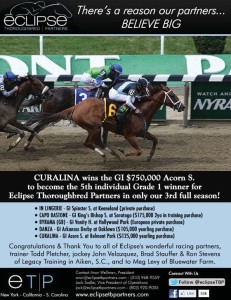 TBP: As a member of the LLC, do they need a social security number or do they need a tax identification number?
TBP: As a member of the LLC, do they need a social security number or do they need a tax identification number?
AW: Either - Everybody can choose to be a member based on their own preference. Some people choose to form LLCs with their horse and their LLC becomes a member of our LLC.
TBP: Are partners billed on a monthly basis?
AW: The most tediously annoying part of owning horses is having to write checks every month. We try to keep that to a minimum. We are full service in every respect. At the outset of a partnership, we collect a quarter of estimated expenses in advance. No one is writing another check for the first three months. That way the partnership is funded for the first quarter. After that, we true up to actual expenses and bill accordingly.
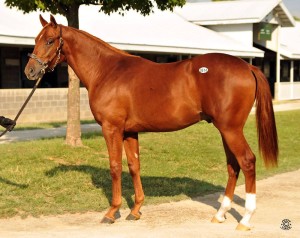 TBP: What do you do when someone comes along who just wants to make money?
TBP: What do you do when someone comes along who just wants to make money?
If anyone ever approaches us with even a hint at an angle at definite ROI or just to simply make money, that is a major red flag for me. The usual thing that I will say to them is, "If you're in this with the intention or expectation of making money, this is not for you." It's not that we are not in this for making money; we do try to make our partnerships profitable endeavors and we take a lot of pride in providing returns to our partners, but that cannot be the perspective that someone comes into horse ownership with. It is purely for entertainment value. You write 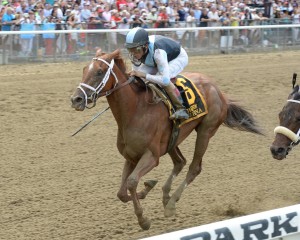 your acquisition check and you forget about it and you continue to do so as long as the horse is in the stable. Anything you get back is a bonus. If you have a good time, it should be considered a success. You can hope that 10% of the horses that you invest in are a success. We pride ourselves on providing a return to our partners, but if that is the reason you are coming to Eclipse, we will tell you that this is not for you and we will give you the opportunity to become educated on the reality of horse ownership.
your acquisition check and you forget about it and you continue to do so as long as the horse is in the stable. Anything you get back is a bonus. If you have a good time, it should be considered a success. You can hope that 10% of the horses that you invest in are a success. We pride ourselves on providing a return to our partners, but if that is the reason you are coming to Eclipse, we will tell you that this is not for you and we will give you the opportunity to become educated on the reality of horse ownership.
TBP: Is it generally word of mouth that generate partners coming in?
We do very little advertising and marketing. When we do, there is usually a purpose behind it beyond just creating partnerships. We sponsor charitable events and those type of things. The best form of advertising is our horses winning on the racetrack. There is no greater promotion than a horse wearing Eclipse colors winning a race at a major venue. That has been the primary source of our organic growth. Part and parcel to the horses doing the talking is our partners doing the talking for us and introducing partners through referral. Between our horses and partners, those are the two most important things. Hopefully they will allow us to carry on the brand with class.
TBP: How can people get in touch with you?
If folks are interested in getting involved in Eclipse, they can contact us through the website, eclipsetbpartners.com. All the appropriate information is there.
TBP: Thank you Aron!
